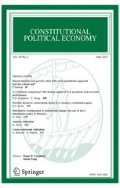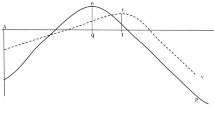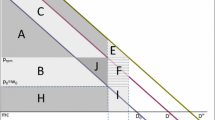Abstract
This paper shows that implicit assumptions about the numeraire good in the Kaldor–Hicks efficiency–equity analysis involve a “same-yardstick” fallacy (a fallacy pointed out by Paul Samuelson in another context). These results have negative implications for cost-benefit analysis, the wealth-maximization approach to law and economics, and other parts of applied welfare economics—as well as for the whole vision of economics based on the “production and distribution of social wealth”.


Similar content being viewed by others
Notes
The change in state could include many projects in one time period or an extended program over many time periods. Also the state changes could be stated in probabilistic terms so that the expected changes in social wealth of the winners would outweigh the expected decreases in social wealth of the losers in the “multi-change hypothetical criterion” (Polinsky 1972, p. 420). But that KH hypothetical criterion suffers from the same methodological fallacy in the hypothetical compensation criterion.
Or keep the compensation payments in money but evaluate all the changes using a non-involved good such as apples. Then the compensation payments like the other changes will change the size of the apple pie (“social wealth” measured in apples). See Ellerman (2009) for the algebraic proof.
References
Blackorby, C., & Donaldson, D. (1990). A review article: The case against the use of the sum of compensating variations in cost-benefit analysis. Canadian Journal of Economics, 23(3), 471–494.
Boadway, R. (2000). The economic evaluation of projects. Kingston Canada: Queen’s University: 51 pp. Retrieved on 14 Dec 2013. http://www.econ.queensu.ca/pub/faculty/flatters/courses/rwb_ben-cost_rev.
Boadway, R., & Bruce, N. (1984). Welfare economics. Oxford: Basil Blackwell.
Buchanan, J. M. (1999). The logical foundations of constitutional liberty: The collected works of James M. Buchanan (Vol. 1). Indianapolis: Liberty Fund.
Ellerman, D. (2014). On property theory. Journal of Economic Issues (forthcoming).
Ellerman, D. (1992). Property and contract in economics. Cambridge, MA: Blackwell.
Ellerman, D. (2009). Numeraire illusion: The final demise of the Kaldor–Hicks principle. In M. D. White (Ed.), Theoretical foundations of law and economics (pp. 96–118). New York: Cambridge University Press.
Friedman, D. D. (2000). Law’s order: What economics has to do with law and why it matters. Princeton: Princeton University Press.
Harberger, A. (1971). Three basic postulates for applied welfare economics: An interpretive essay. Journal of Economic Literature, 9(3), 785–797.
Hicks, J. R. (1939). The foundations of welfare economics. Economic Journal, 49(196), 696–712.
Hicks, J. R. (1941). The rehabilitation of consumers’ surplus. Review of Economic Studies, 8(2), 108–116.
Hicks, J. R. (1975). The scope and status of welfare economics. Oxford Economic Papers, 27(3), 307–326.
Kaldor, N. (1939). Welfare propositions of economics and interpersonal comparisons of utility. Economic Journal, 49(195), 549–552.
Polinsky, M. (1972). Probabilistic compensation criteria. Quarterly Journal of Economics, 86(3), 407–425.
Posner, R. (2001). Cost-benefit analysis : Definition, justification, and comment on conference papers. In M. D. Adler & E. A. Posner (Eds.), Cost-benefit analysis: Legal, economic, and philosophical perspectives (pp. 317–341). Chicago: University of Chicago Press.
Samuelson, P. (1961). The evaluation of ’social income’: Capital formation and wealth. In F. A. Lutz & D. C. Hague (Eds.), The theory of Capital (pp. 32–57). London: Macmillan.
Samuelson, P. (1972). Foundations of economic analysis. New York: Atheneum.
Samuelson, P. (1979). Complementarity: An essay on the 40th anniversary of the Hicks–Allen revolution in demand theory. Journal of Economic Literature, 12(4), 1255–1289.
Scitovsky, T. (1941). A note on welfare propositions in economics. Review of Economic Studies, 9, 77–88.
Willig, R. (1976). Consumer’s surplus without apology. American Economic Review, 66, 589–597.
Author information
Authors and Affiliations
Corresponding author
Rights and permissions
About this article
Cite this article
Ellerman, D. On a fallacy in the Kaldor–Hicks efficiency–equity analysis. Const Polit Econ 25, 125–136 (2014). https://doi.org/10.1007/s10602-014-9159-x
Published:
Issue Date:
DOI: https://doi.org/10.1007/s10602-014-9159-x




